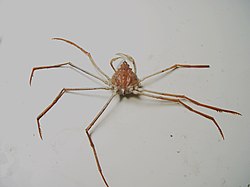| Inachoididae | |
|---|---|
 | |
| Anasimus latus | |
| Scientific classification | |
| Domain: | Eukaryota |
| Kingdom: | Animalia |
| Phylum: | Arthropoda |
| Class: | Malacostraca |
| Order: | Decapoda |
| Suborder: | Pleocyemata |
| Infraorder: | Brachyura |
| Superfamily: | Majoidea |
| Family: | Inachoididae Dana, 1851 |
Inachoididae is a family of crabs originally erected by James Dwight Dana in 1852. It was not recognised as a valid family until the early 1980s. [1] Its members closely resemble those of the family Inachidae, and the Inachoididae could be recognised as a subfamily of that family. [1]
- Aepinus Rathbun, 1897
- Anasimus A. Milne-Edwards, 1880
- Arachnopsis Stimpson, 1871
- Batrachonotus Stimpson, 1871
- Collodes Stimpson, 1860
- Euprognatha Stimpson, 1871
- Inachoides H. Milne-Edwards & Lucas, 1842
- Leurocyclus Rathbun, 1897
- Paradasygyius Garth, 1958
- Pyromaia Stimpson, 1871